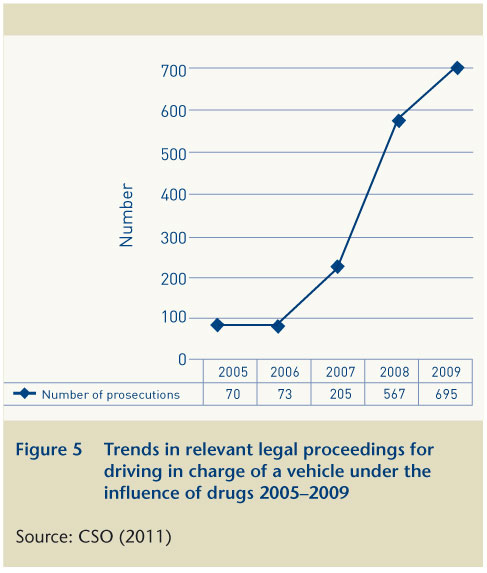Connolly, Johnny (2011) Drugs and crime data. Drugnet Ireland, Issue 39, Autumn 2011, pp. 21-23.
| Preview | Title | Contact |
|---|---|---|
| PDF (Drugnet Ireland 39) - Published Version |
This article looks at trends in reported drug offences and drug seizures for various periods between 2003 and 2010. It should be noted that drug offence and seizure data are primarily a reflection of law enforcement activity. Consequently, they are affected in any given period by such factors as law enforcement resources, strategies and priorities, and by the vulnerability of drug users and drug traffickers to law enforcement activities. Having said that, drug seizures are seen as indirect indicators of the supply and availability of drugs.


The offence of obstructing the lawful exercise of a power conferred by the Misuse of Drugs Act 1977 (s.21) continues to account for a large majority of offences each year. Obstruction offences often involve an alleged offender resisting a drug search or an arrest or attempting to dispose of drugs to evade detection. Following a decline in 2008, proceedings for such offences increased in 2009, as they did for cultivation offences and forged prescription offences. Importation offences decreased marginally in 2009. Proceedings for the cultivation or manufacture of drugs have continued to increase, rising from 29 in 2005 to 163 in 2009. It is unclear whether this increase reflects a genuine growth in the commission of such offences or a sustained concentration of law enforcement on detecting them.

It can be seen from Figures 3 and 4 that prosecutions for possession decreased in all but two Garda regions (the Northern and the South Eastern) in 2009, after a steady increase since 2006.

The Dublin Metropolitan Region still accounts for the majority of prosecutions for possession in the state. However, the proportion of prosecutions taking place outside the capital has increased significantly, from 43.6% in 2003 to 63.3% in 2009. These data show that the drug phenomenon is now more widely distributed throughout the state than previously.

Figure 5 shows the trend in prosecutions for driving under the influence of drugs (DUID) between 2005 and 2009, when the number rose from 70 to 695, an increase of more than 900%. It is unclear why this increase has occurred. It could be due either to an increase in the incidence of DUID or, the more likely possibility, an increase in targeted police activity in this area.

The reduction in the total number of reported seizures in 2009 and its levelling off in 2010 may also be explained by a reduction in the number of seizures of other drugs since 2008. Figure 7 shows trends in seizures for a selection of drugs, excluding cannabis, between 2003 and 2010. There has been a significant decline in seizures of cocaine, heroin and ecstasy-type substances since 2007. It appears that the significant reduction in total drug seizures reported in 2009 can be explained primarily as the result of a reduction in seizures of cannabis and cocaine. However, in 2010 we have seen the continued decline in heroin seizures. It is unclear whether this reflects a decline in heroin use or a change in law enforcement activities or some other factor.

1. Connolly J (2005) The illicit drug market in Ireland. HRB Overview Series 2. Dublin: Health Research Board. www.drugsandalcohol.ie/6018
MM-MO Crime and law > Justice and enforcement system
VA Geographic area > Europe > Ireland
MM-MO Crime and law > Crime > Substance related crime
MM-MO Crime and law > Criminal penalty / sentence
A Substance use and dependence > Substance related societal (social) problems > Drug use and driving
MM-MO Crime and law > Crime > Substance related crime > Crime associated with substance production and distribution
Repository Staff Only: item control page